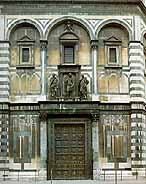
Andrea Pisano, the South Door
The three entrance doors to the Baptistery open onto
the east, north and southern sides of the square. The
main entrance is placed on the eastern side, facing the Cathedral,
with the the apse and the altar in the interior of San
Giovanni behind it.
The magnificent sets of doors in gilded bronze that were to become even more
famous than the temple itself were all originally designed and made for this
entrance. Andrea da Pontedera, known as Andrea Pisano, was the first artist to
work here and only took seven years (1330-1336) to complete his pair of doors:
this was quite an noteworthy performance if we remember that this was the first
time that a bronze cast of this size had ever been carried out in Gothic art.
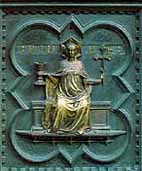
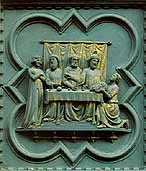
Two panels by Andrea Pisano
Andrea divided the two doors into 28 compartments or panels (14 to each
door), surrounded by a frame of rosettes and lions' heads. The interior
of each panel, framed with the typical Gothic "polylobate"
surround, contains twenty episodes from the life of the Baptist,
and eight figures of Virtues in the lower part. Each composition
is well constructed, with a close relationship between figures and
background, while the rythm of the narrative is constant and contained,
without surprises. This is therefore a "classical" and
not a Gothic vision of the narrative, bringing Andrea Pisano closer
to Giotto (with whom he was later to work on the Belltower)
than his contemporary, Giovanni Pisano, who also bore the same surname.
The new doors remained here for the whole of the 14th century. In fact, it was
not until 1401 that the Florentine Republic decided
to announce a competition for a second pair of doors; these were again for the
east side, replacing the previous ones, which were to be moved to the south side,
where they can still be seen today (the present entrance into the Baptistery).
Some of the finest artists in Tuscany took part in the competition, seven great
artists in all, among them Filippo Brunelleschi,
Jacopo della Quercia and the sculptor and goldsmith Lorenzo Ghiberti, who was
only twenty-three at the time.
The subject, which was to be carried out on a panel, was the Sacrifice of Isaac.
Both Brunelleschi and Ghiberti entered their own different interpretations of
the subject, which were considered equally good, however it was the latter, whose
work was still partly Gothic in style and therefore easier to understand, who
actually won and was given the commission. The two panels they presented for
the competition are now exhibited beside each other in the Museum of the Bargello.
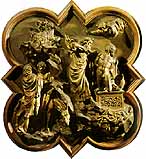
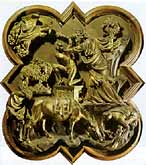
The panels by Ghiberti and Brunelleschi at the Bargello
The contract for the execution of the work was signed on November 23rd 1403 but the doors were to take Ghiberti and his workshop twenty years to complete: they were finally hung in the east entrance in 1424, replacing the doors by Andrea Pisano. The contract of the artist (who in the meantime also worked on other works of art), stipulated that he produce at least three panels a year, for which he would receive 200 florins in exchange (making a total of 4.000), while he was also allowed to employ collaborators, providing he personally carried out the trees and the faces of the figures, including their hair. Great artists of the future like Donatello and Paolo Uccello were among his pupils.
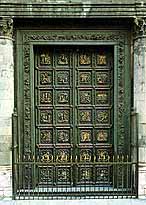
Ghiberti, the
North Door
The structure of the door is very much like the earlier one: 28 panels
surrounded by the usual "polylobate" Gothic frame which was, in
its turn, placed inside a square decorated with plant motifs. The only variation
was that the lions' heads were substituted by those of the Prophets. The
small head in the centre of the left-hand door portrays Ghiberti himself.
20 panels illustrate scenes from the life of Christ, while the remaining
8 contain the Evangelists and the Fathers of the Church.
Several details hint at the the coming of the Renaissance,
especially the approach to some of them (the Dispute of Christ with the Doctors
of the Church), and show the trend towards a freer naturalism; the model that
was followed however was still based on Andrea Pisano's Gothic style.
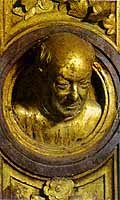
Portrait of Ghiberti
on the Door of Paradise
This second pair of doors was also acclaimed by the Florentines, who immediately
decided to commission Ghiberti, now at the height of his career, with the
execution of yet another set of doors, this time without a competition,
which were to be placed at the north entrance.
These doors took 27 years to complete (1425-1452), but the result was so outstanding
(even Michelangelo said that they were "worthy
of Paradise"), that they were hung on the east side, in the place of honour,
and Ghiberti's first set of doors was moved to the north entrance (where they
can still be seen today).
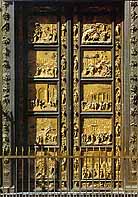
Ghiberti, the
Door of Paradise
Their structure is completely different: the panels are reduced to 10,
five to each door, and are surrounded by a continuous sequence of small
heads, floral motifs and niches which, in their turn, contain small statues
of Prophets and Sybils. The iconographic formula, dedicated to stories from
the Old Testament, was created by Leonardo Bruni, humanist and chancellor
of the Republic.
Ghiberti followed it by inserting more than one episode in each panel, using
daring but coherent perspective solutions. By this time the artist had absorbed
a great deal from the artistic experience of his ex-pupils Paolo Uccello and
(especially) Donatello, apart from having helpers like Michelozzo and
Benozzo Gozzoli working under him during this period.
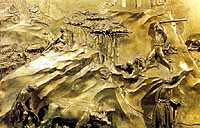
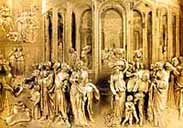
Two panels from the Door of Paradise
Its secret in fact lies in the perspective, by that time a law of expression,
evoking skies, distant woodlands, buildings, groups of figures and personalities
that project sharply outwards and are sculpted in what is almost high relief.
The Doors of Paradise thus become Ghiberti's masterpiece and unified all
his skill as a goldsmith and sculptor, for the gold highlights he used created
wonderful perspective and pictorial effects, giving it a precious finish
that was also an integral part of the composition.
This was revealed when the doors were restored, first in 1948, and then in 1966,
after the damage caused by the flood. The doors were replaced by copies after
the latter intervention and the original panels are now preserved in the Museum
of the Opera del Duomo.
